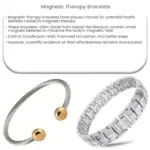Explore magnetic therapy bracelets, their potential benefits like pain relief and improved circulation, and the scientific evidence behind them.
Understanding Magnetic Therapy Bracelets
Magnetic therapy bracelets have gained popularity in recent years as a non-invasive, drug-free alternative for pain relief and overall wellness. These bracelets contain magnets that are thought to have therapeutic effects on the body. This article will explore how magnetic therapy bracelets work, their potential benefits, and the scientific evidence supporting their use.
How Magnetic Therapy Bracelets Work
Magnetic therapy bracelets are designed with small, powerful magnets embedded into the material. When worn, these magnets are said to create a magnetic field that interacts with the body’s own bioelectromagnetic field. This interaction is believed to stimulate blood flow, promote relaxation, and alleviate pain.
The human body contains charged particles such as ions, which are essential for various physiological processes, including nerve and muscle function. Proponents of magnetic therapy suggest that the magnetic field generated by the bracelets helps to align these charged particles, improving circulation and reducing inflammation.
Potential Benefits of Magnetic Therapy Bracelets
- Pain relief: One of the most common reasons people turn to magnetic therapy bracelets is for pain relief. Some users report experiencing relief from joint pain, muscle aches, and even headaches after wearing these bracelets.
- Improved circulation: Magnets may help increase blood flow, which can reduce inflammation and promote healing. This may be particularly beneficial for individuals with poor circulation or conditions like Raynaud’s disease.
- Reduced stress and anxiety: Wearing a magnetic therapy bracelet may have a calming effect on the body, helping to alleviate stress and anxiety. Some users claim that they feel more relaxed and balanced after wearing their bracelet.
- Better sleep: Some individuals report improved sleep quality when wearing a magnetic therapy bracelet. This may be due to the bracelet’s calming effects, as well as its potential to improve circulation and reduce inflammation.
Scientific Evidence and Controversy
Despite the anecdotal claims, scientific evidence supporting the effectiveness of magnetic therapy bracelets remains limited. Some studies have found modest improvements in pain relief and circulation, while others have reported no significant benefits. The lack of consensus among researchers is largely due to the variation in study designs, magnet strengths, and treatment durations.
It is important to note that wearing a magnetic therapy bracelet is generally considered safe, with few reported side effects. However, individuals with pacemakers or other implanted medical devices should consult their healthcare provider before using magnetic therapy products.
Conclusion
In conclusion, while magnetic therapy bracelets have many anecdotal claims of providing relief for various ailments, scientific evidence remains inconclusive. If you are considering trying a magnetic therapy bracelet, it is essential to consult with a healthcare professional to discuss potential benefits and risks. Keep in mind that these bracelets should not replace conventional medical treatments but may be used as a complementary therapy alongside other treatment options.



